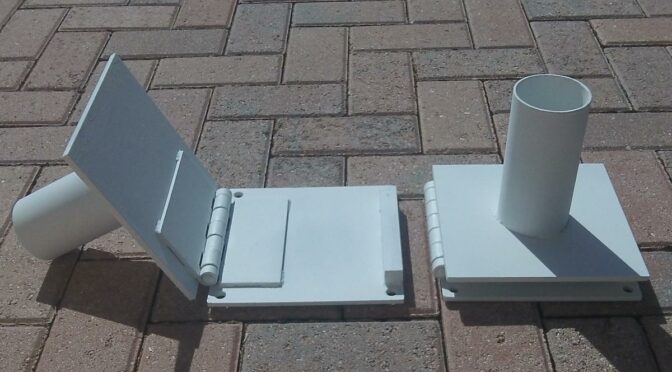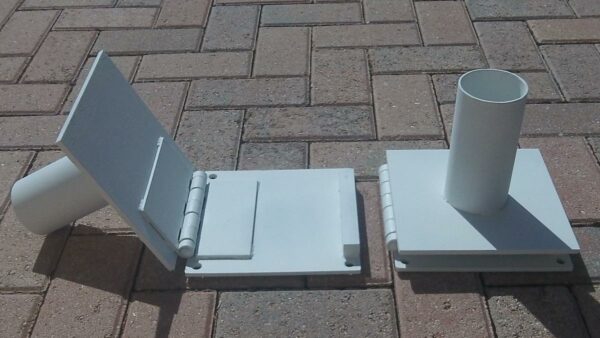Introduction
Remote station operation has become more popular now that several rig manufacturers offer accessories to enable the radio amateur to do so. However, there is usually a large expense associated with acquiring these accessories. For some, it may not be cost-effective to own them for occasional use. In this article, we describe a solution for remote operation from another room of your home, your yard, or while on travel. It is also convenient for controlling on/off functions in the shack with the click of the mouse. The solution revolves around a Velleman relay card that can control a number of relays from a computer desktop.
The Power Station
This article describes a USB-controlled AC power strip, Figure 1, that was built around the Velleman K8090 8-Channel Relay Board in kit-form [1]. Varistors were added to the board as a recommended option [2]. The board can also be purchased fully assembled [3].

Figure 1. USB Controlled Power Strip. Each 15A duplex outlet is under USB control. There are just enough contacts on the barrier strip for 8 relays, neutrals, and grounds.
The PC communicates to the board via USB. A free, desktop, graphical user interface (GUI) is provided by Velleman for use as test software, or you may opt to purchase an application such as N-Button Lite [4].
Some type of rig interface is required to control your rig and audio from a PC. You may use the interface in your rig if it has one, or buy or build one of your own.
In order to log onto your computer, see your desktop remotely and hear rig audio, some kind of conferencing software is required. I use TeamViewer [5] to see my desktop and hear computer audio remotely.
Cautionary Notes
You will be dealing with AC line voltage in this project. Keep the clear polycarbonate cover on the enclosure while AC power is applied. Since the Velleman card operates on 12 VDC and control is over USB, all testing can be completed prior to plugging the AC line cord into the wall socket.
The FCC requires some means to disable the transmitter within 3-minutes if something goes wrong during remote operation. Velleman makes a WMT1206 Universal Timer Module with USB Interface [6] that should prove useful for this application. Its relay can handle 8A of AC. There are also similar USB timer modules available on eBay. It’s also a good idea to have the ability to reboot your computer remotely. The exact details of how to implement this FCC requirement are left to the reader but there are plenty of suggestions to be found online.
Kit Construction
An experienced kit builder can assemble and test the board in an afternoon. The added varistors are specified at 125J, 300VAC, 385VDC, and 4500A clamping peak current [7]. If these are not readily available, there are equivalents. A suggestion was made to thicken the circuit board traces that must handle the 16A relay current with additional solder. I didn’t care for this approach and opted to solder bus wire onto these traces, instead. You might find it ludicrous to solder #14 AWG buss wire onto the board, so your other option is to derate the relay capabilities to what the conductors can safely handle since the PCB traces have not been rated. For example, the ampacity of #20 AWG buss wire is at least 5A (11A at 75°C) [8], and that will be good for 575W. None of the circuits that I run from this PCB require anywhere near 575W. Take care not to damage the PCB traces while soldering. Excessive heat will lift the PCB traces.
Housing, Connectors, and AC Outlets
There are 8 duplex outlets in this project – each one under separate relay control. Each outlet has been wired with #14 AWG. Each relay is rated at 16A, resistive load (see the previous section for derating). The duplex outlets have been spaced far apart so that a variety of line cords and wall adapters will fit without interference. The control board is housed in a Bud Industries PN-1340-C polycarbonate enclosure [9] with a clear cover (not affixed), Figure 2. The clear cover provides visibility for the status lights on the PCB. Bud Industries also manufactures an internal aluminum panel, PNX-91440 [10], upon which the PCB and barrier strip have been mounted. Take care in locating connectors on the housing or the PCB will not fit. The PCB is fastened to the aluminum panel with 4-40 hex standoffs. The Bud Industries enclosure is fitted with 1/2-inch male terminal adapters [11] at either end. DC power for the relays enters the enclosure at the top left through a 2.1mm panel mount connector [12]. The relay power required is 12VDC at 400mA. A 12 VDC wall adapter with a 2.1mm plug can provide this voltage. AC power enters the housing through a cable gland at the lower left. Switchcraft makes the USB connector at the lower right. It converts USB A inside the enclosure to USB B on the outside. The connector was purchased from Newark [13]. The short USB jumper patch cord was purchased on Amazon [14]. A step drill [15] is the most effective way to bore the large holes in a polycarbonate or ABS case without cracking it.

Figure 2. Interior View of Control Board Enclosure. Eight 16A relays are visible. There’s not much space to spare. Take care in wiring the AC connections and in locating the connectors on the housing or the PCB will not fit.
Software Apps
The test software that is supplied by Velleman for the circuit card is adequate, or N-Button Lite [16] may be purchased Figure 3. A screenshot of the lower right corner of the monitor shows the buttons for N-Button Lite. The green buttons indicate that four of the eight relays are active. If you purchase the Bud enclosure with a clear polycarbonate cover as I did, you will be able to see all eight red indicator lights on the Velleman board, one for each relay. They will light when a relay becomes active.

Figure 3. Screenshot of PC desktop. N-Button Lite controls each of 8 relays.
References
References
[1] https://www.jameco.com/z/K8090-Velleman-8-Channel-USB-Relay-Card-Kit_2123952.html
[2] https://www.velleman.eu/products/spareparts/?code=vdr300
[3] https://www.amazon.com/Velleman-VM8090-8-Channel-Relay-Card/dp/B00CPCQ88Y
[4] https://www.serialporttool.com/GK/n-button-lite/
[5] https://www.teamviewer.com/en-us/?utm_source=google&utm_medium=cpc&utm_campaign=us|b|pr|19|jul|Brand-TeamViewer-Exact|free|t0|0|dl|g&utm_content=TeamViewer_Exact&utm_term=teamviewer&gclid=Cj0KCQjw5ZSWBhCVARIsALERCvzZflNoCfAiFgi9STEIDiJkCtRuazuukru
[6] https://whadda.com/product/universal-timer-module-with-usb-interface-wmt206/
[7] Velleman, op. cit. https://www.velleman.eu/products/spareparts/?code=vdr300
[8] https://en.wikipedia.org/wiki/American_wire_gauge
[9] https://www.budind.com/product/nema-ip-rated-boxes/pn-series-nema-box/ip65-nema-4x-box-with-clear-cover-pn-1340-c/ – group=series-products&external_dimension
[10] https://www.budind.com/accessories/aluminum-internal-panel-pnx-91440/
[11]https://www.homedepot.com/p/1-2-in-Male-Terminal-Adapter-R5140103/202043509
[12] https://www.amazon.com/2-1mm-DC-Power-Jack-Chassis/dp/B073PKZPQ7
[13] https://www.newark.com/switchcraft-conxall/ehusbbabxpkg/usb-adapter-type-b-rcpt-a-rcpt/dp/08N9043?gclid=Cj0KCQjw5ZSWBhCVARIsALERCvycmWj-i38ykHaPrlbG8Eb-uxCyxcpZzdNWmZ0r7Z2iV9zgd7CpVKAaAh5KEALw_wcB&mckv=_dc|pcrid||plid||kword||match||slid||product|
[14] https://www.amazon.com/inch-USB-2-0-Male-Cable/dp/B079ZP65SN?th=1
[15] https://www.homedepot.com/s/step%2520drill?NCNI-5
[16] Relay Pros, op. cit. https://www.serialporttool.com/GK/n-button-lite/















